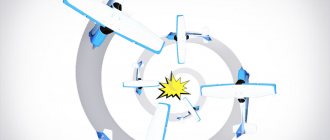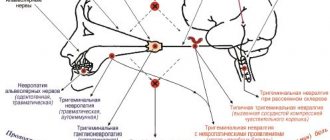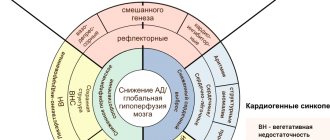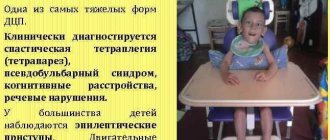Reception is conducted by:
Belyakova Alla Vasilievna -
pediatric neurologist
Make an appointment
Fainting is a clinical situation accompanied by a short-term loss of consciousness. Pathology develops due to metabolic disorders in brain cells and oxygen deficiency. The corresponding problem is rarely an independent disease. In 90% of cases it accompanies pathology of other internal organs. The specialists of the Profimedica clinic will help in such a situation and tell parents how to behave in the future.
Causes of fainting in children
Children of any age are susceptible to fainting. The key to this issue is a sudden decrease in the flow of blood or glucose to brain cells, which causes neurocytes to temporarily “turn off.”
Possible reasons:
- severe pain syndrome;
- very strong emotion (joy, fear);
- prolonged fasting;
- massive blood loss;
- infectious diseases accompanied by intoxication shock;
- mental overload. Due to the immaturity of the brain, the baby cannot always withstand the pressure usual for an adult patient.
A common cause of this situation is traumatic brain injury. The baby may fall and hit himself hard, causing him to lose consciousness.
First aid for a fainting child
If a child faints, parents should under no circumstances panic and provide their child with emergency assistance. To do this you must:
- Place the child on his back and raise his legs 30 degrees to ensure blood flow to the brain.
- Unfasten constrictive clothing and allow fresh air to enter.
- Place a wet towel on your forehead and lightly sprinkle your face with water.
- After the child comes to his senses, do not let him get up immediately. Some more time is needed to restore blood circulation.
- Give sweet tea or juice to drink.
Parents should remember that fainting in a child can be a symptom of a serious illness and self-medication is completely unacceptable. You should immediately consult a doctor and, if necessary, undergo a comprehensive examination.
Symptoms of fainting
The clinical picture of the corresponding pathology can be divided into the pre-fainting stage, the phase of loss of consciousness and the post-fainting state.
The following symptoms are warning signs of a problem:
- severe weakness;
- dizziness;
- paleness of the skin;
- slow breathing;
- nausea;
- darkening of the eyes;
- cold sweat.
After this, the child loses consciousness. In the post-harvest state, the patient complains of weakness and general poor health. The duration of the unconscious period depends on the individual characteristics of the organism. The baby may not come to his senses from several seconds to several minutes.
What is fainting and its symptoms
Fainting is a short-term loss of consciousness caused by metabolic disorders in the brain. Symptoms of impending fainting in a child are:
- dizziness;
- noise in ears;
- severe weakness;
- nausea;
- blurry vision;
- pale skin;
- increased sweating.
Fainting in a child, as a rule, is very frightening for parents. And for good reason, as this may be evidence of serious health problems.
Diagnostic measures
If loss of consciousness is often observed in children, it is recommended to establish the cause of the pathology. Experts recommend the use of instrumental and laboratory examination methods:
In case of syncope in children, a general clinical blood test is performed. To rule out diabetes, it is recommended to take a blood test that determines the amount of sugar. An electrocardiogram is prescribed to check the functioning of the cardiovascular system.
To establish the cause of the pathology, a teenager must visit highly specialized doctors - an endocrinologist, cardiologist, neurologist. If syncopal syndrome occurs, 24-hour cardiac monitoring is recommended. If changes occur, an ultrasound examination of the organ is performed.
If a child is able to faint frequently, this raises suspicions of tumors in the brain. This diagnosis is confirmed or refuted using magnetic resonance imaging. Taking an anamnesis is an important diagnostic procedure . The victim must honestly answer the doctor’s questions and remember all the events of his life.
The doctor determines the factors that could have caused the teenager to faint. He clarifies the frequency of occurrence of such conditions and determines family history. The integrated use of diagnostic methods determines adolescent fainting and allows us to develop an effective treatment regimen.
Forms
There are several forms of fainting, directly depending on the reasons that cause them. Modern medicine divides fainting into the following forms and types.
Neurogenic - occurs when the regulation of the human nervous system is disrupted. This form of fainting includes emotiogenic fainting (pain, fear and other strong emotions); overheating in the sun or excessive physical exertion can lead to maladaptive fainting in adults and children; dyscirculatory is caused by a sharp disruption of cerebral blood supply.
Somatogenic syncope usually occurs during certain human illnesses. For example, people with heart disease may experience cardiogenic syncope (cardiac arrest, cardiac arrhythmia). Low hemoglobin and insufficient levels of red blood cells in the blood cause anemic fainting (pregnant women often suffer from it). Due to a sharp decrease in blood sugar levels, hypoglycemic fainting may occur.
Extreme fainting - this form includes all types of loss of consciousness by a person under the influence of unfavorable environmental conditions and extreme factors. Hypoxic - occurs when there is a lack of oxygen in the air; hypovolemic - characteristic of heavy blood loss or burns; poisoning with alcohol, drugs, organic and chemical substances leads to intoxication fainting. Medicinal - most often occurs with an overdose or improper use of medications. Increased atmospheric pressure leads to hyperbaric syncope in humans.
How treatment and preventive measures are carried out
When identifying the true causes of fainting, it is important to eliminate them, then there will be no fainting states. Among general activities, it is imperative to follow a daily routine, strictly monitor timely food intake and proper sleep. Nutrition should be age-appropriate, rich in all essential nutrients, minerals and vitamins; a sufficient supply of light carbohydrates is also important.
It is useful to do morning exercises, go to the pool, play sports, but do not overwork. For children with high excitability, baths with sedative herbs and sea salt are useful. In case of abnormalities in the ECG, drugs are used that nourish the heart muscle and the underlying diseases are treated.
Alena Paretskaya, pediatrician, medical columnist
5, total, today
( 60 votes, average: 4.92 out of 5)
Loss of consciousness: causes and first aid for fainting
First aid for burns - thermal, chemical and electrical
Related Posts
Signs of loss of consciousness
There are three groups of signs of loss of consciousness:
- Presyncope are harbingers of loss of consciousness. These include strong increasing noise and ringing in the ears, sudden weakness (“knees buckle”), and a feeling of numbness in the upper and lower extremities. The fainting state lasts literally 10-20 seconds.
- Actually fainting - there is no consciousness, breathing becomes weak and shallow, the pupils dilate, and convulsions may appear.
- Post-fainting state. The victim experiences severe weakness, and if he suddenly rises to his feet, the fainting may recur. Shortness of breath, throbbing headache, and tremors of the upper extremities are noted.
Symptoms of fainting typical of childhood
The duration of loss of consciousness and the depth of “blackout” can vary significantly in children of different ages. Usually fainting does not last more than a couple of minutes; longer ones are dangerous in terms of more serious disorders of consciousness. It is typical for a child who has fainted to have pale skin and a cold, clammy sweat. In addition, breathing during fainting is shallow, the chest rises slightly. The pressure is uniformly reduced in the arms and legs, the peripheral pulse is weakly palpable, it is often very slow, but can be replaced by a rapid one. When the child assumes a horizontal position, the fainting attack quickly passes, which is associated with the distribution of blood in a different direction, increasing its flow to the head. Often the condition normalizes without medical intervention, after first aid.
When a child faints, it is always unexpected and frightening for parents. Doctors tell us how to recognize an approaching loss of consciousness and what to do if you faint.
Fainting is a short-term loss of consciousness due to a suddenly developed reversible disruption of the blood supply to the brain. Usually, loss of consciousness develops quickly, but fainting has “precursors”: a feeling of lightheadedness, severe weakness, flashing “spots” before the eyes. Due to a sudden decrease in muscle tone, the child may fall, and there is a high risk of head injury.
Symptoms of fainting also include increased sweating, rapid heartbeat, nausea, pale skin, blurred vision, and dizziness. And after an attack, the child may feel weak and drowsy. Fainting too often can lead to learning difficulties.
Causes of fainting
The main cause of fainting is a lack of blood supply to the brain. This may be a violation of vascular tone in which orthostatic collapse occurs - a condition that occurs when a person suddenly rises from a lying or sitting position to a standing position. At the same time, the veins of the lower extremities do not have time to tone up, the brain experiences a deficiency of blood and, consequently, glucose.
Violation of vascular tone is associated with autonomic failure, which can also lead to loss of consciousness. The fact is that with vegetative-vascular dystonia the body is not adapted to changing environmental conditions (changes in ambient temperature, atmospheric pressure). Fainting can also be caused by strong emotions (fear), a sharp decrease in blood pressure, disruption of the patency of the arteries supplying blood to the brain, and low concentration of glucose in the blood, which is the main source of energy for the brain. Causes of fainting also include irregular heart rhythm and short-term cardiac arrest.
Fainting can also be caused by anemia, poisoning, overheating, increased atmospheric pressure, loss of circulating blood volume (with burns, blood loss) and insufficient oxygen in the inhaled air.
Treatment of fainting
At the moment of an attack, you need to catch a falling child to protect him from injury. Then you need to put it so that the head is lower than the body, raise your legs so that the blood flows to the head. It is important to provide access to fresh air (open the window, free the patient’s neck) and spray the face with cold water, let them breathe over a cotton swab moistened with ammonia. Then, to improve brain nutrition, it is necessary to inject the patient intravenously with a glucose solution or give him something sweet to eat.
In the period between attacks, it is recommended to carry out restorative treatment with drugs that improve brain nutrition, the body’s adaptation to changing environmental conditions, venous tone, and vitamins B, C, A.
At the doctor
Analysis of complaints and medical history includes answers to the following questions: how long ago did the first cases of fainting appear; with what frequency do they appear? whether fainting is provoked by something or occurs spontaneously; whether the child is taking any medications.
Typically, your doctor will order a blood test to measure the amount of red blood cells (red blood cells), hemoglobin (the protein that carries oxygen in the blood), and glucose.
To study the functioning of the heart, you will need to do an electrocardiogram. Dopplerography of the neck vessels may also be necessary, this will allow you to check the patency of the vessels supplying blood to the brain.
Prevention of fainting involves a balanced and rational diet. It is recommended to eat foods high in fiber (vegetables, fruits, greens), and avoid canned, fried, spicy, and hot foods. Meals should be frequent and small; 5-6 small meals per day are allowed). Moderate physical activity will be useful: swimming and daily walks in the fresh air for at least two hours.











